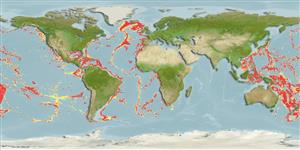Common names from other countries
>
Ophidiiformes (Cusk eels) >
Ophidiidae (Cusk-eels) > Neobythitinae
Etymology: Xyelacyba: Greek, xyele, -es = plane (tool) + Greek, kybeia, -ou = a fish (Ref. 45335).
More on author: Cohen.
Environment: milieu / climate zone / depth range / distribution range
экология
морской батидемерсальный; пределы глубины 984 - 2500 m (Ref. 34024). Deep-water
Possibly worldwide in tropical and subtropical seas (but not yet caught in the eastern Pacific) (Ref. 34024). Eastern Atlantic: 2 specimens between 12°N and 9°25'N. Western Atlantic: Gulf of Mexico to off southern Brazil. Northwest Pacific: Ashizuri Cape, Japan.
Size / Вес / Возраст
Maturity: Lm ? range ? - ? cm
Max length : 57.0 cm TL самец/пол неопределен; (Ref. 3686)
Краткое описание
определительные ключи | морфология | морфометрия
членистые (мягкие) лучи спинного плавника (общее число) : 89; членистые (мягкие) лучи анального плавника: 74. Body and tail strongly compressed, snout round and short, no spine on tip. Head and body uniformly whitish, margins of median fins light brown, jaws, pelvic fins, mouth and gill cavities deep brown. Peritoneum and stomach deep brown, intestine yellowish.
A benthopelagic species at bathyal depth (Ref. 56809). Found on the continental slope (Ref. 75154). Rare species (Ref. 34024). Reproductive strategy possibly similar to other members of this family featuring oviparity, with oval pelagic eggs floating in a gelatinous mass (Ref. 205).
Life cycle and mating behavior
Maturities | размножение | Spawnings | Egg(s) | Fecundities | личинки
Nielsen, J.G., D.M. Cohen, D.F. Markle and C.R. Robins, 1999. Ophidiiform fishes of the world (Order Ophidiiformes). An annotated and illustrated catalogue of pearlfishes, cusk-eels, brotulas and other ophidiiform fishes known to date. FAO Fish. Synop. 125(18):178p. Rome: FAO. (Ref. 34024)
Статус Красного Списка МСОП (Ref. 130435)
CITES (Ref. 128078)
Not Evaluated
Угроза для людей
Harmless
Использование человеком
рыболовство: интереса не представляет
дополнительная информация
инструменты
Специальные отчеты
Скачать в формате XML
ресурсы в Интернет
Estimates based on models
Preferred temperature (Ref.
115969): 2.5 - 5.2, mean 3.5 (based on 1299 cells).
Phylogenetic diversity index (Ref.
82804): PD
50 = 1.0000 [Uniqueness, from 0.5 = low to 2.0 = high].
Bayesian length-weight: a=0.01122 (0.00514 - 0.02450), b=3.04 (2.87 - 3.21), in cm Total Length, based on all LWR estimates for this body shape (Ref.
93245).
Trophic level (Ref.
69278): 3.7 ±0.6 se; based on size and trophs of closest relatives
устойчивость к внешним воздействиям (Ref.
120179): средний (среднего размера), минимальное время удвоения популяции 1.4-4.4 года (Preliminary K or Fecundity.).
Fishing Vulnerability (Ref.
59153): Moderate vulnerability (43 of 100).
